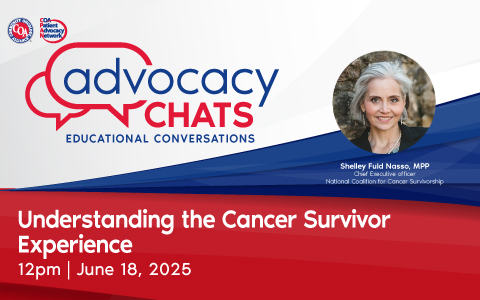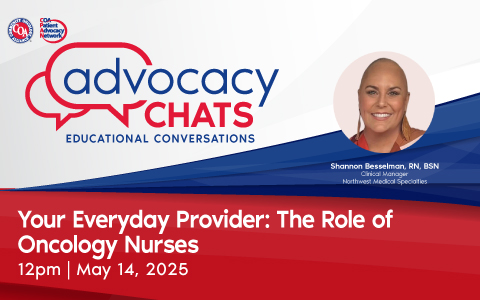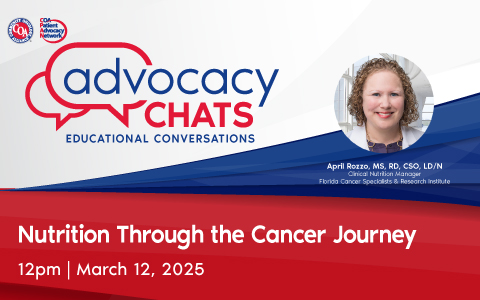The Crystal Ball for Cancer Policy in 2022
There are so many important aspects to the cancer experience, but what we really focus on at the Community Oncology Alliance (COA) is the care component and Ted Okon, COA’s executive director, focused on the care component and shared his insights for the January 2022 CPAN Advocacy Chat. He also told us what to expect at the federal and state levels and what will be COA’s focus for 2022.
What Are the Biggest Issues Relating to Cancer Care Policy?
If you ask the question, “What is the biggest issue relating to cancer care policy?”, the answer is drug pricing. Cancer care really comes down to drug pricing, drug pricing, drug pricing. This chat was devoted to looking at some aspects of drug pricing. Why? Because cancer drugs are expensive, and many politicians love to bash pharma. While not making apologies or excuses for some of what pharma does on drug pricing, it must be said that pharma is delivering in almost lightning speed some of the most incredible vaccines available. It is quite easy to point fingers at pharma, but the actual problem is more complicated than that.
I do not want to get too far into the weeds or as some would say “wonky,” but the issue is a bit wonky. It is quite easy to say that the problem with drug pricing and the reason people must pay so much for drugs is a pharma problem. It is not. Pharma certainly is on the hook for the underlying drug prices, but the thing we need to underscore is that when someone in the United States purchases a drug, pricing is about the cost to the individual – the price they pay – but not about the underlying drug price. That distinction is so important.
If you look at a drug cost, it is a function of several factors. It is a function of the drug list price. You would think the higher the list price, the higher the cost, but that is not always the case. Price is also a factor of benefit design, meaning your insurer – What is your co-pay? What is your deductible? All of that affects cost. What your provider does is also a factor in terms of marking up drugs to determine what the cost is to you. And it is also a function of insurer formularies. A person may or may not be able to get a drug because it is on an insurer list of formularies or a restricted list because of what the insurer and/or the pharmacy benefit manager (PBM) does in terms of the formulary and the kind of rebates the PBM gets, therefore the way they set the price of a drug. So, this is a complicated issue.
Whenever I am asked what the biggest topics in cancer care policy are right now, not only in Washington D.C., but also across the country, I say, “drug pricing.” For purposes of clarity, it’s worth explaining that a formulary is a list of which drugs you may have. If a drug is off formulary, even though your physician may say they want that specific drug for a patient, the only way you will get that drug is if your insurer will make a special exception.
The Reality of Drug Price Dynamics
Think of the sticker price for an automobile or the listed price for a house as the “list price.” The “net price” is the price after rebates and other things bring down the list price. I am not defending pharma, nor am I taking the pharma position and being apologetic. I look at what Biogen has done with its new Alzheimer’s drug and drug pricing, and it is inexcusable. Pharmaceutical companies have a role in setting list prices, but it is an interesting dynamic.


While the list price for drugs from each of the companies has gone up, the net price has gone down. It is particularly important to understand that there is a fundamental difference between the list price and net price. When people ask why drug prices are so high, they are talking about the list price.
A recently published study from the Berkeley Research Group (BRG) found that the middlemen in the drug supply chain (pharmacy benefit managers and hospitals) get more than half – 51%– of the gross drug expenditures. Only 37% goes to brand manufacturers, and 11% goes to generic manufacturers. What does this mean? It means that pharmaceutical companies must set their list prices higher because they are going to get hit by rebates and discounts that bring the net price, or what they get, down. If you look at the period from 2013 to 2020, the part of the revenue that the manufacturer retains from a drug sale has gone down, and the part that the entities in the supply chain gets has gone up, so they now make more that the manufacturer does.
Hospitals profit from drug prices. A study by COA in 2021, which is on the COA website at 340B Hospital Drug Price Profits Report, reviewed the median drug mark-up by 340B hospitals, which is over half of the hospitals in the United States and who receive special discounts on drugs, revealed that they are charging 3.8 times more than their cost for a drug. For a drug like Epogen, which is used in cancer supportive care, the mark-up is 11%. 340B hospitals are supposed to use the discounts they receive for the benefit of the under-insured and indigent community, but the study found that 340B hospitals charge the same median price for cash paying or uninsured patients as they do for insurers. What does that mean?
Let’s go back to list and net prices. When you get a bill from a hospital, it will typically have a huge artificial mark-up. Yes, there is an underlying list price set by the drug companies, but the individual’s price far outpaces the list price through no action by the drug companies. Another story is the purchase by hospitals of community oncology practices. Because hospitals make so much money on drugs, especially cancer drugs which are among the most expensive drugs, they have a huge incentive to pressure independent cancer practices that are not part of the hospital system to sell to them. COA has story after story of patients in the middle of treatment going to their community oncology practice the week before a hospital purchases the practice, paying one price, and the next time paying a higher price for the same services in the same place, performed by the same people.
A Real Example of Hospital Drug Profits

Let’s look at Darzalex, a drug used to treat multiple myeloma. When a community oncology practice purchases that drug for a Medicare patient being treated over a period of one year for $116,876, they are reimbursed $123,889. The $7,013 differential is not a pure profit as the practice has to pay for the procurement, storage, and preparation of the drug. If that same Medicare patient goes to a 340B hospital, that same amount of Darzalex is purchased for $76,320, and the hospital is reimbursed in the amount of $90,579. The hospital gains $14, 259 for treating that patient for one year because Medicare sets the reimbursement rates for treating Medicare patients. But look what happens when the hospital treats a commercially insured patient with that same drug. The hospital purchases the drug at the 340B reduced rate of $76,320, but they are pricing it to the insurer at $290,016. That is a $213,696 profit. In this case, there is no correlation between the manufacturer’s list price and what the drug might cost the patient.
PBMs Profit from Cancer Drugs
PBMs are top Fortune 100 corporations that control virtually all of the prescription drugs in this country. They are like water meters. They don’t own the water; they don’t supply the water; but they control the water, or in this case, all prescription drugs. The top three PBMs, who are also tied to the largest health insurers, control upwards of 80% of all prescription drugs. CVS Health owns Aetna; Express Scripts is owned by Cigna; and OptumRx is owned by United Healthcare.
PBMs started out processing drug claims; they adjudicated claims at the pharmacy level. What they do now is act as an intermediary between pharmaceutical manufacturers and providers by negotiating drug prices. They offer to negotiate drug prices on their behalf with an insurer or an employer. The problem is that PBMs profit from high drug list prices. They have a vested interest in a higher list price because the higher the list price, the more PBMs profit. So, what do they do? They go to manufacturers and say that the company’s drugs will not appear on their formularies unless they give the PBM a rebate. They extract, some would say extort, rebates from pharma to include their drugs on formularies and so they want the list price to be as high as possible. They also extract after-sale fees from pharmacists. Several months after the consumer pays for a drug, the pharmacy is hit with a fee, called a direct or indirect remuneration (DIR) fee that doesn’t really serve a purpose other than “pay to play.” If a pharmacy were to refuse to pay the fees, they would find themselves becoming out-of-network for up to 80%of all covered lives.
PBMs profit by extorting this rebate based upon a high list price or downstream by DIR fees from pharmacists. Sadly, this is no different than a mob guy who walks into a store and asks the owner if he has fire insurance. The owner who replies he has not had a fire in 25 years will be told he needs to pay up or there might be a fire. Collectively, PBMs and their insurers adversely impact cancer care. They not only fuel higher drug list prices, but they also restrict, delay, and in some cases even deny treatment because they control the formularies; they are able to dictate when, where, and if treatment is given.
Pharmacy Formulary Exclusions
PBMs also control what is called step therapy. Step therapy dictates a patient must fail on an inferior drug not prescribed by their oncologist before the patient can have access to the drug actually prescribed by their physician. This is a real problem for patients with cancer.
Increasingly, PBMS are using their influence to dictate which drugs many patients, including patients with cancer, may have access to.

COA’s Crystal Ball on D.C. and State Drug Prices
The Democrats in Congress tried to advance, as part of the Build Back Better Act, the ability of the Centers for Medicare & Medicaid Services to “negotiate” prescription drug prices in the Medicare program. This was a highly partisan issue. Many people thought it was a promising idea for the largest purchaser of drugs to negotiate prices. It sounds like a particularly good idea that they use their weight to negotiate prices down. The problem with the Build Back Better Act approach is it deals with prices of drugs with no competition after they are on the market which could fuel initial drug list prices because without a competitor there is no real negotiation – the government would say “take it or leave it.” And if the company were to leave, they would end up paying a 95%excise tax on all sales.
This would not stop hospitals and PBMs from marking up and fueling drug prices. As an unintended consequence, it could cause hospitals and PBMs to mark up prices even more. COA was very much against this portion of the bill because it put providers, especially oncologists, in the middle of government and pharma “negotiations.” That put undue financial exposure to oncologists by lowering reimbursement because prices were negotiated but making their practices not financially viable. If that were to happen, patients would pay more when the community oncology practice closed, and they were forced to get care from a hospital where it is more expensive.
The Build Back Better Act is now dead in the water and the Democrats may try later this year to advance drug pricing legislation. This is a big issue on both sides of the aisle, but it is not clear how they will try to do it. At this point, it is unclear how this comes back because the President needs every Democratic vote and Senator Manchin appears opposed. Even with the tie breaking vote from Vice President Kamala Harris, there are not enough votes to pass the Act.
It is interesting that the House Committee on Oversight and Reform held a forum on PBMs, at which I testified. The forum was about PBMs and how they fuel drug prices. So, what is going to happen on the PBM issue while the Build Back Better Act is, for the moment, dead? I believe we will see more on this issue, especially on the Republican side. Senator Wyden, a Democrat and the Chair of the Senate Finance Committee, has been very vocal on PBM fees and especially the after-sale DIR fees. On January 4, the Biden administration moved to force PBMs to disclose all after-sale fees (DIR fees) up front so when a person covered by Medicare goes into a pharmacy, they will then pay the lower fee, so drug costs are lowered for Medicare seniors. This is the first meaningful step to acknowledging that the drug pricing problem is not all a pharma problem and that PBMs are a real issue.
State after state after state have come forward to regulate PBMs. The states are actually far ahead of the federal government on this issue. It is because so many people, including COA member oncologists, have been so active.
COA 2022 Priorities
COA’s biggest priority is to bring down treatment costs for cancer patients. Specifically, drug prices. We want to:
- Advance legislation that would provide pharma 340B discounts directly to patients in need rather than go to hospital profits.
- Advance legislation that would stop PBMs from denying and delaying cancer treatment, especially by restricting where patients can get their drugs.
- Support legislation and the Biden administration in stopping PBM rebates and after-sale pharmacy fees that artificially fuel drug prices.
- Stop restrictive PBM and insurer tactics that limit treatment options for patients with cancer.
- Advance the use of effective, but less expensive, biosimilar drugs.
- Stop misguided public policy that puts community oncology practices in undue financial harm’s way leading to clinic closings and mergers into more expensive hospital systems.
When clinics close, patients must understand that they will no longer have access to that community oncology clinic with which they have formed such a bond. Those clinics would be gone, and patients would no longer have access to local, affordable care. This is what this whole issue is about, especially in rural areas.
Additional priorities include:
- Continuing to help practices navigate COVID-19
- Heighten the awareness of the adverse impact of COVID on cancer screenings and treatment.
- Continue to push the public service announcement campaign, “Time to
- Screen,” launched in 2021, which focuses on the importance of cancer screenings.
- Work with employers to understand how they can provide their employees with the highest quality, most affordable cancer care close to home
One of the biggest things on COA’s plate is the concept of health disparities and working to close those gaps.
Crystal Ball on the Midterm Elections
It is a long time until the November 2022 elections but even the most ardent Democrats will tell you that:
- As of now, Republicans take the House and Senate.
- The threat of Democrats losing the House and Senate is forcing them to go big on issues, like drug pricing, rather than taking an incremental approach.
- The $60,000 question is, “Will a divided government bring policymakers together or just further divide them?”
- Republicans will likely put less emphasis on pharma in drug pricing investigations and more on the middlemen like PBMs.
CPAN Advocacy Chats are regular virtual events where a guest speaker is invited to join us to discuss issues important to advocacy and advocates in a 30-minute webinar.
CPAN Advocacy Chats are regular virtual 30-minute educational conversations about cancer advocacy and policy with a guest speaker invited to discuss issues important to patients and advocates. Summaries of previous Advocacy Chats are available on the CPAN website.
Past Advocacy Chats





